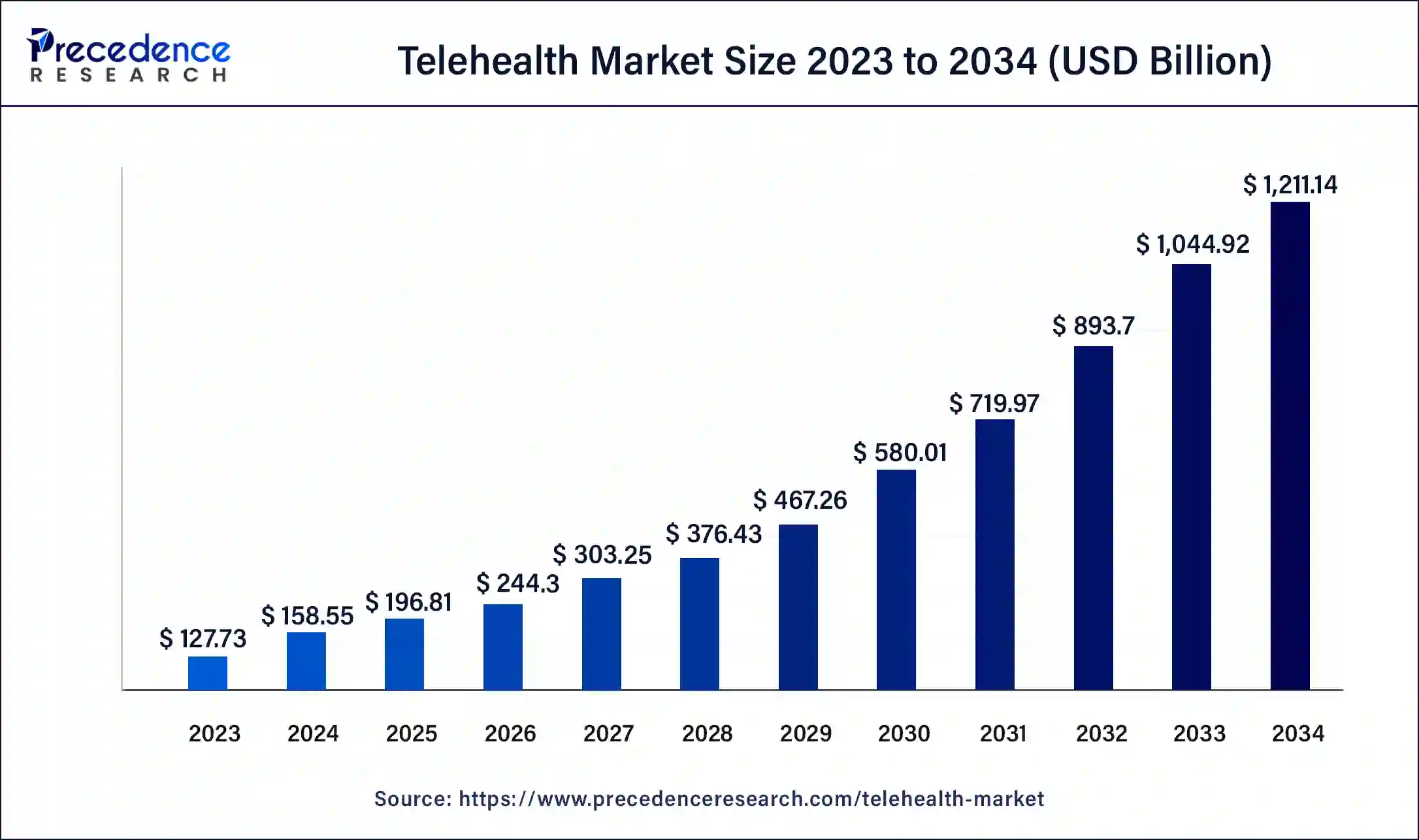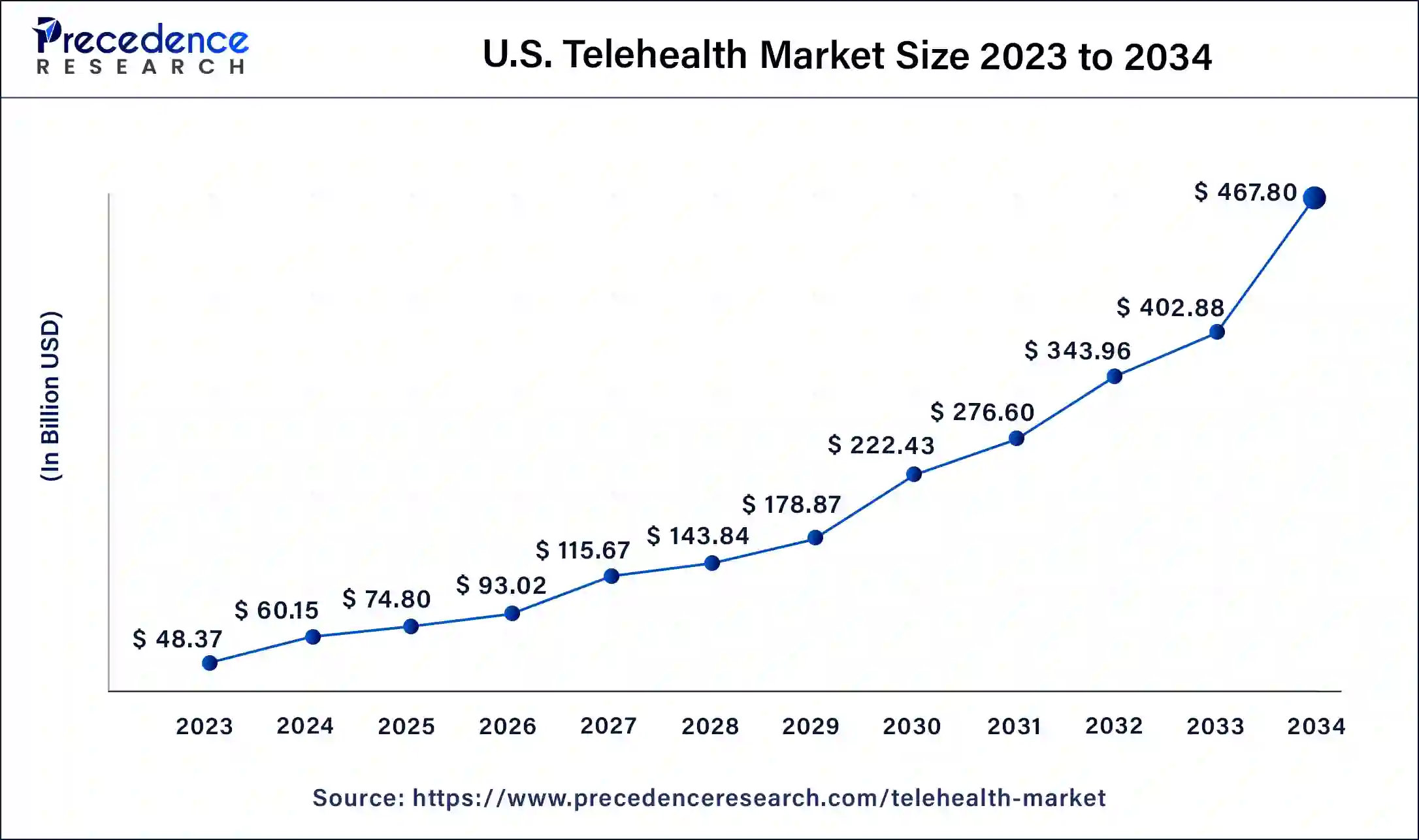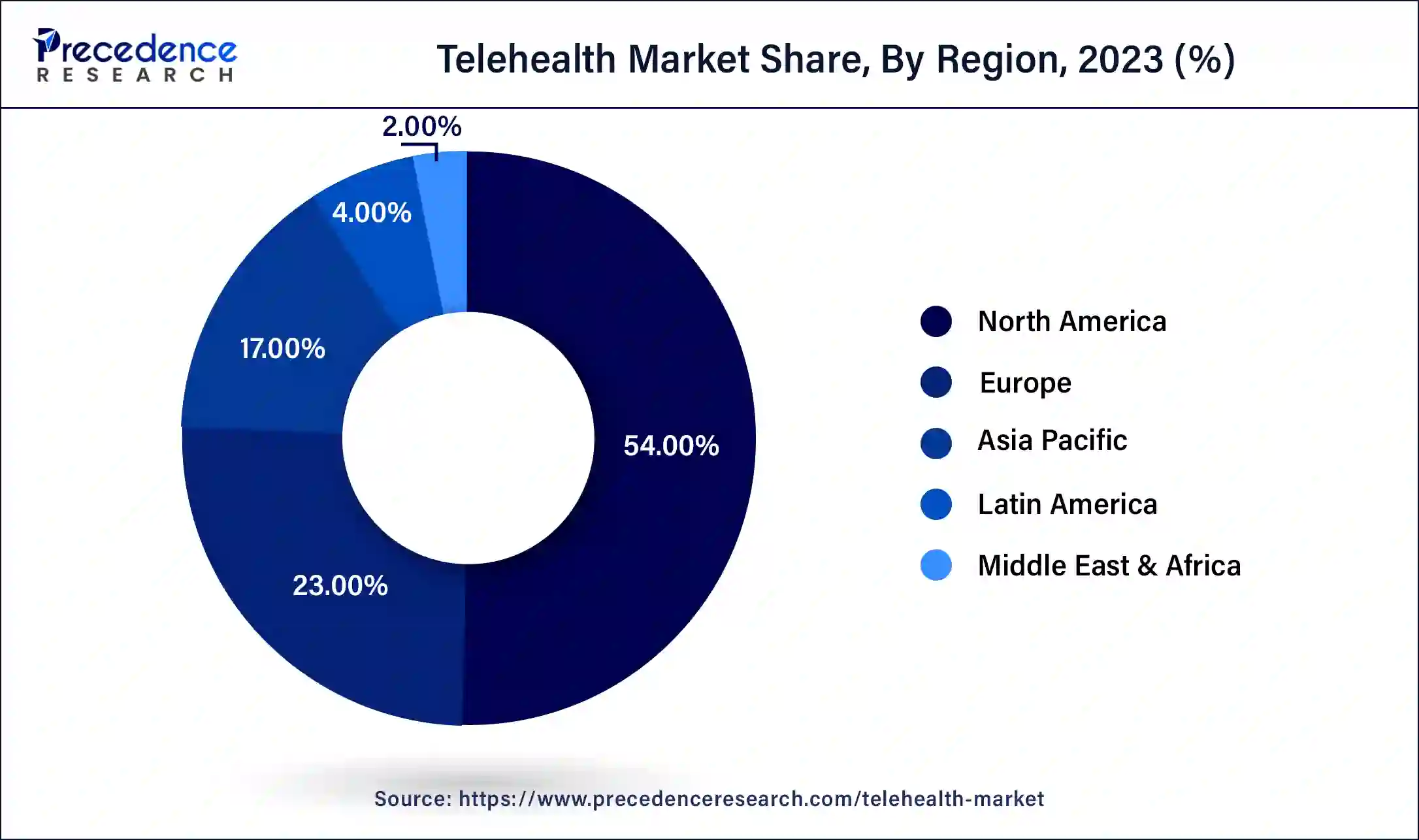December 2024
The global telehealth market size is calculated at USD 196.81 billion in 2025 and is expected to reach around USD 1,211.14 billion by 2034, expanding at a CAGR of 22.5% from 2025 to 2034. The North America telehealth market size surpassed USD 85.62 billion in 2024 and is expanding at a CAGR of 22.66% during the forecast period. The market sizing and forecasts are revenue-based (USD Million/Billion), with 2024 as the base year.
The global telehealth market size accounted at USD 158.55 billion in 2024 and is predicted to increase from USD 196.81 billion in 2025 to approximately USD 1,211.14 billion by 2034, expanding at a CAGR of 22.55% from 2025 to 2034.

The U.S. telehealth market size was exhibited at USD 60.15 billion in 2024 and is predicted to be worth around USD 467.80 billion by 2034, at a CAGR of 22.77% from 2025 to 2034.

North America was the largest contributor to the global telehealth market and accounted for 54% share in 2024 A large group of people with various chronic health conditions, coupled with better access to treatment for various acute and chronic diseases, is the primary factor for its high market share. The strong presence of key telehealth players is also another reason for the high uptake of telehealth solutions in North America. The rise in the patient pool with various diseases and the necessity to treat the disease with modern treatment options, such as the use of digital technologies, will boost the market growth during the forecast period.
Currently, North America is dominating the telehealth market. The strong healthcare infrastructure and quick access to telehealth services boost the growth rate of the region. The government initiatives and advanced digital health technology are the initial contributions to the market. North America holds the highest internet penetration rate. Virtual care platforms can be integrated with existing systems. It includes remote diagnosis and virtual hospital services. Remote patient monitoring consists of smart sensors and wearable devices that enable healthcare providers to able to monitor patients’ health conditions remotely. Artificial intelligence technology personalizes treatment plans and analyzes patient data.

On the other hand, Asia Pacific is estimated to be the most opportunistic market during the forecast period. Asia Pacific is estimated to grow due various factors such as largest population, rapid urbanization, rising investments on healthcare infrastructure, and increased investments on the IT infrastructure. Further, the use of advanced technologies can significantly reduce the healthcare costs, which drives the adoption of telehealth in the Asia Pacific region.
The global telehealth market is driven by the growing demand for digital and convenient healthcare products and services among hospitals and consumers across the globe. Telehealth platforms are gaining rapid traction among consumers owing to the availability of healthcare professional services like consultations at the press of a button. The rising investments on the development of IT infrastructure and the rising adoption of smartphones and the internet among the global population are fostering the growth of the telehealth market. According to ITU, around 4 billion people were using the internet by the end of 2019. Most of the internet users operate through their smartphones. Doctors and physicians are now increasingly adopting telehealth platforms for offering consultations and other services. Telehealth is rapidly becoming an important distribution channel for the physicians for offering their services. Therefore, the increased demand for the telehealth platforms among both the consumers and the doctors is augmenting the global telehealth market.
The rising prevalence of chronic diseases and growing geriatric population are among the major drivers of the telehealth market. Furthermore, the rising number of hospitals and clinics across the globe is boosting the adoption of telehealth. Telehealth keeps a track of patients’ medical health and supplies useful insights to the doctors during the treatment of the patients. This helps the doctors to provide effective treatment to the patients. Moreover, the geriatric patient needs to be monitored continuously and hence rising geriatric population is fueling the demand for the telehealth platforms. The rising penetration of telehealth apps across the globe is contributing exponentially towards the market growth. Further, various developmental strategies by the key market players like acquisitions, partnerships, and new product launches is boosting the growth of the global telehealth market.
| Report Highlights | Details |
| Market Size by 2034 | USD 1,211.14 Billion |
| Market Size in 2024 | USD 158.55 Billion |
| Market Size in 2025 | USD 196.81 Billion |
| Growth Rate From 2025 to 2034 | CAGR of 22.55% |
| Largest Market | North America |
| Fastest Growing Market | Asia Pacific |
| Base Year | 2024 |
| Forecast Period | 2025 to 2034 |
| Segments Covered | Component, End User, Application, Mode of Delivery and Region |
| Regions Covered | North America, Europe, Asia-Pacific, Latin America, and Middle East & Africa |
Increased patient engagement
Telehealth enables patients to access healthcare services from the comfort of their homes or any location. As patients find it easier to engage with healthcare providers through telehealth, the demand for telehealth services increases, driving the market’s growth. Patient engagement encourages individuals to take a more proactive role in managing their health. Through telehealth platforms, patients can access their health data, receive personalized treatment plans and communicate with healthcare professionals. Beyond traditional healthcare services, telehealth services often offer various health and wellness services such as mental counselling and nutrition consultations. These services attract a broader range of patients who are actively engaged in improving their overall well-being. Thus, the increased patient engagement is observed to act as a driver for the market.
Lack of training and education
Telehealth systems or tools are technologically advanced and can be complicated to manage. Thus, healthcare professionals may require specific training and education to effectively utilize telehealth tools or platforms. A lack of knowledge or training might hinder the full utilization of telehealth capabilities. If used in a wrong way, the system or tool may create a wrong outcome for patients. The proper management of such systems is crucial as it handles multiple patient records, data and prescriptions. Thus, lack of training and education about these systems and tools is observed to hinder the market’s growth.
Integration of artificial intelligence
Artificial intelligence models can analyze patient data to create personalized treatment plans based on an individual’s unique medical history, genetic makeup and lifestyle factors. This level of personalization can lead to more effective treatments and better patient compliance. AI-powered chatbots and virtual health assistants can offer basic medical advice, answer common health-related questions, and assist patients with managing chronic conditions. This relieves some of the burdens on healthcare providers and enhances patient engagement. Thus, the integration of artificial intelligence-based models in telehealth tools is observed to create an opportunity for the market.
Technical challenges and limitations
Telehealth relies heavily on technology, and technical issues such as connectivity problems, software glitches or hardware malfunctions can disrupt patient-doctor communication and overall user experience. Some medical conditions may require physical examinations or specialized diagnostic procedures that are difficult to replicate in a telehealth setting. The inability to perform hands-on assessments might limit the scope of telehealth in certain cases. Thus, the technical challenges and limitations are observed to pose a challenge for the market.
Technological advancements in the telehealth market feature remote patient monitoring, virtual care platforms, telepharmacy, and medical drones. Telepharmacy provides a remote consultation facility to patients. It enables receiving prescriptions and maintaining timely medications. Medical drones mainly work as a transporter of medical supplies. It also delivers medication to underdeveloped or rural areas. Cloud computing and IoT technology provide data storage, sharing, and analysis. Big data and analytics analyze patient data, supporting personalized care. AR and VR technology are beneficial for training medical professionals, enhancing and improving patients’ experiences.
Based on the component, the services segment hit the largest revenue share of 50% in 2024.
The hardware consists of wide variety of devices and are extensively used in the hospitals, clinics, and homecare telehealth devices. Various hardware used consists of mobile frame, communication lines, computer systems, therapeutic devices, video feed, and various others. The extensive usage along with the high prices of the hardware has resulted in a huge revenue generated by this segment.
The software segment is anticipated to be the fastest-growing segment during the forecast period. The rapid development and updates in the software system to enhance the efficiency and effectiveness of the telehealthdevices is exponentially boosting the segment growth. Moreover, it plays an important role in remotely monitoring the patient’s health condition. This factor is boosting the growth of this segment.
The hospitals segment dominated the global telehealth market in 2024, in terms of revenue and is estimated to sustain its dominance during the forecast period. This can be attributed to the increasing adoption of telemedicine in the healthcare sector. The deployment of telehealth platforms such as telemedicine and tele-ICU can help to reduce the burden on the physicians and doctors in the hospitals. Moreover, the rising number of hospitals and private clinics in the developed and developing markets are expected to drive the demand for the telehealth in the upcoming years. The rising demand for the technologically advanced devices is rising across the global healthcare industry in order to improve operational efficiency, reduce cost, and increase profitability.
The homecare segment is estimated to be the most opportunistic segment during the forecast period. This is attributed to the increasing awareness regarding the hospital acquired infections, growing geriatric population, and increased disposable income. Most of the old age people likes to get the treatment staying at their homes and hence the homecare segment is expected to drive the growth of the telehealth demand. Further, the rising awareness regarding the hospital acquired infections resists the patients to go to the hospitals and compels the patients to obtain treatment from the comfort of their homes.
The telemedicine segment dominated the global telehealth market in 2024, in terms of revenue and is estimated to sustain its dominance during the forecast period. The rapid penetration and growth of the telemedicine across the globe in past year has resulted in the increased adoption of the telemedicine among the consumers. Moreover, the emergence of numerous telemedicine players in the market has significantly contributed towards the growth of the market. Furthermore, the advancements in the cloud-based storage services is complementing the telehealth market by providing quick access to data.
The patient monitoring segment is expected to be the fastest-growing segment during the forecast period. This is attributable to the increased demand for the continuously monitoring of the patients especially the old age patients. Further, the rapid adoption of the smart medical wearable devices is augmenting the segment growth, which continuously tracts the health condition of the user. According to the American Telemedicine Association, approximately one million people are using cardiac monitoring devices, which is expected to rise further. This is a major driving force behind the patient monitoring segment.
The market is moderately fragmented with the presence of several local companies. These market players are striving to gain higher market share by adopting strategies, such as investments, partnerships, and acquisitions & mergers. Companies are also spending on the development of improved products. Moreover, they are also focusing on maintaining competitive pricing.
The various developmental strategies like acquisition and new product launches with latest and innovative features fosters market growth and offers lucrative growth opportunities to the market players.
By Component
By End User
By Application
By Mode of Delivery
By Region
For inquiries regarding discounts, bulk purchases, or customization requests, please contact us at sales@precedenceresearch.com
No cookie-cutter, only authentic analysis – take the 1st step to become a Precedence Research client
December 2024